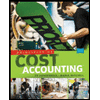
Concept explainers
Concept introduction:
Predetermined
Predetermined overhead allocation is a method of allocation of overhead costs to the product units. Under this method, the overhead costs are allocated to the product units using the allocation base. The allocation base is identified based on the type of production activities.
Requirement-1:
To calculate: The amount of overhead cost assigned to job W.
Concept introduction:
Predetermined overhead allocation:
Predetermined overhead allocation is a method of allocation of overhead costs to the product units. Under this method, the overhead costs are allocated to the product units using the allocation base. The allocation base is identified based on the type of production activities.
Requirement-2:
To indicate: The way the cost of job W cost sheet shall be reported in the financial statement at the end of the year.
Want to see the full answer?
Check out a sample textbook solution
Chapter 3 Solutions
MANAGERIAL ACCOUNTING FOR MANAGERS EBOOK
- Please answer do fast and step by step calculation with explanation of the accounting questionarrow_forwardPlease read my financial accounting question properly and give correct answerarrow_forwardWhat is maria's net income after these transaction? Please solve the general accounting questionarrow_forward
- Principles of Accounting Volume 2AccountingISBN:9781947172609Author:OpenStaxPublisher:OpenStax College
 Managerial Accounting: The Cornerstone of Busines...AccountingISBN:9781337115773Author:Maryanne M. Mowen, Don R. Hansen, Dan L. HeitgerPublisher:Cengage Learning
Managerial Accounting: The Cornerstone of Busines...AccountingISBN:9781337115773Author:Maryanne M. Mowen, Don R. Hansen, Dan L. HeitgerPublisher:Cengage Learning Excel Applications for Accounting PrinciplesAccountingISBN:9781111581565Author:Gaylord N. SmithPublisher:Cengage Learning
Excel Applications for Accounting PrinciplesAccountingISBN:9781111581565Author:Gaylord N. SmithPublisher:Cengage Learning  Principles of Cost AccountingAccountingISBN:9781305087408Author:Edward J. Vanderbeck, Maria R. MitchellPublisher:Cengage Learning
Principles of Cost AccountingAccountingISBN:9781305087408Author:Edward J. Vanderbeck, Maria R. MitchellPublisher:Cengage Learning Cornerstones of Cost Management (Cornerstones Ser...AccountingISBN:9781305970663Author:Don R. Hansen, Maryanne M. MowenPublisher:Cengage Learning
Cornerstones of Cost Management (Cornerstones Ser...AccountingISBN:9781305970663Author:Don R. Hansen, Maryanne M. MowenPublisher:Cengage Learning College Accounting, Chapters 1-27AccountingISBN:9781337794756Author:HEINTZ, James A.Publisher:Cengage Learning,
College Accounting, Chapters 1-27AccountingISBN:9781337794756Author:HEINTZ, James A.Publisher:Cengage Learning,





